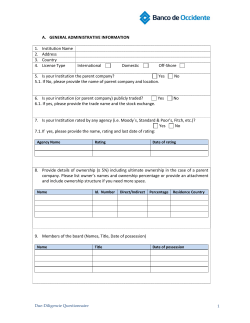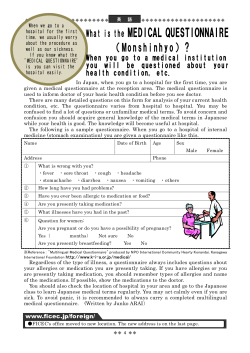
HOW TO DESIGN A QUESTIONNAIRE – A TUTORIAL
HOW TO DESIGN A QUESTIONNAIRE – A TUTORIAL www.healthsurveysolutions.com HOW TO DESIGN A QUESTIONNAIRE WHAT A QUESTIONNAIRE CAN TELL US Patterns, frequency, ease and success of use User needs, expectations, perspectives, priorities and preferences User attitudes and opinions Trends (by repetition over time) Health status Quality of life Symptoms THE AIM OF YOUR SURVEY Seems obvious but, it is essential that the first thing to do is determine exactly what the aim of the survey is. This is more than a rough idea of what the survey is about - see below Main Outcomes. It is about specifically specifying what and how you want to measure. For example if you are interested in people’s health status, just what does that mean? You need to be specific. Is it their physical, psychological status? Once this has been decided then the concepts you want to be measured needs to be operationalised in measurable terms. YOUR SURVEY POPULATION Defining your study population is an essential first step for any research and is no less important when designing a questionnaire as it has a significant bearing on the questionnaire's content and the chosen method for collecting the data. Defining your study population is more than a cursory step. For example, if your survey is to study the experiences of people with diabetes to their care, you would need to determine whether this would involve both type 1 and type 2 diabetes as there can be a difference in the type of care and support received by the different types of diabetes. Will your survey include the elderly? If so web based and telephone interviews may not be appropriate. What is the expected level of literacy of the target population? These are just some of the issues that must first be clarified. DECIDE ON THE METHOD OF DATA COLLECTION Questionnaires can applied in a number of different formats including, paper, web, hand held tablet based, telephone, self-administered and interviewer based. Selecting the appropriated method of data collection will depend on a number of key factors including, the population, resources, costs and time. See above. Click here to review some of the features for different methods of data collection. YOUR MAIN OUTCOME(S) Without establishing exactly what the desired outcomes are of your survey it will fail . Establishing the main outcomes is closely linked to the aims of the survey. But, there is more. For example, the aim of the study might be to examine the relationship between patient and staff experience in the care received. However, the desired outcomes might be what if any are the solutions to improving the patient's care. Therefore the survey questionnaire needs to be designed in order to capture that specific information. Closely linked is how and what is the information to be disseminated and what are the key messages communicated? For example, will the information be used to apply for further funding or to put a case for more staff? What channels will be used to communicate the outcomes, social media, presentations, report etc? All these kind of issues must be considered before design of the questionnaire starts. DESIGNING THE SURVEY QUESTIONNAIRE Draft the questionnaire, considering content, wording, format, structure and layout. Things to consider: Can the question be easily understood? Are the questions too vague? Are the questions biased? Is the question necessary? Will respondents be willing to provide the information? Is the question relevant to all respondents? Is the first question easy to answer? Types of questions There are two different question types which are open - Can you suggest ways to improve the service? and closed - Choosing from the options below how satisfied or dissatisfied would say you are with the time you had to wait to be seen by your GP? Response options These include: Categorical e.g. Is your sex male or female? Ordinal: Strongly agree, agree, neither agree or disagree, disagree, strongly disagree Balanced ordinal, when the two endpoints mean the direct opposite e.g. Strongly agree v Strongly disagree o Ranked, choices are ordered from the highest to the lowest. e.g. How important are the following services to you which are provided by your GP? o o o PRETESTING THE QUESTIONNAIRE It is essential that the questionnaire is tested on a sample of people from the population who will take part in the study. This is to ensure that respondents can complete the questionnaire, do not have problems understanding the question or are missing sections of the questionnaire. A more valid approach is to conduct cognitive debriefing interviews with 10 or so people who are representative of the target population to identify weakness in the wording of questions and questionnaire layout. COLLECTING THE DATA A well designed questionnaire will always help improve response rates. There are however, other considerations which include: Give clear instructions in a different typeface from the questions Include information setting out the purpose of the questionnaire. Ensure that the questionnaire is self-explanatory and stands alone. Introduce the questionnaire. The covering letter may go missing. "Sign off" by thanking the respondent If your plan is to conduct an online survey, tablet or handheld, then there is a need to consider the following additional points: Respondent knows how far along the process he/she is Respondent can review information already provided No doubts about information security Respondents are told they are doing well AN ITERATIVE PROCESS Remember that much of good survey design is arrived at through an iterative process, and through trial and error. At the same time, where possible, it is good practice to test or pilot your survey. Ideally you should pilot your survey with members of your sample universe. Of course the research process does not end with the survey construction; the real value is in the interpretation and, for that reason, it is vital that those conducting the analysis and reporting have been part of the questionnaire design process too. HealthSurveySolutions DHP Research Bloxham Mill Business Centre Barford Road, Bloxham Banbury, Oxfordshire OX15 4FF Email: info@healthsurveysolutions.com Tel: 44 (0) 1295 724233 www.healthsurveysolutions.com
© Copyright 2025





















